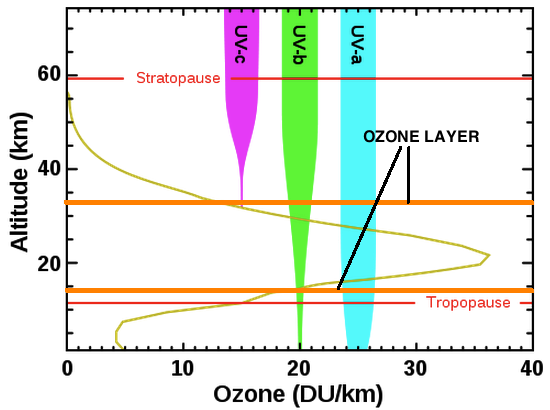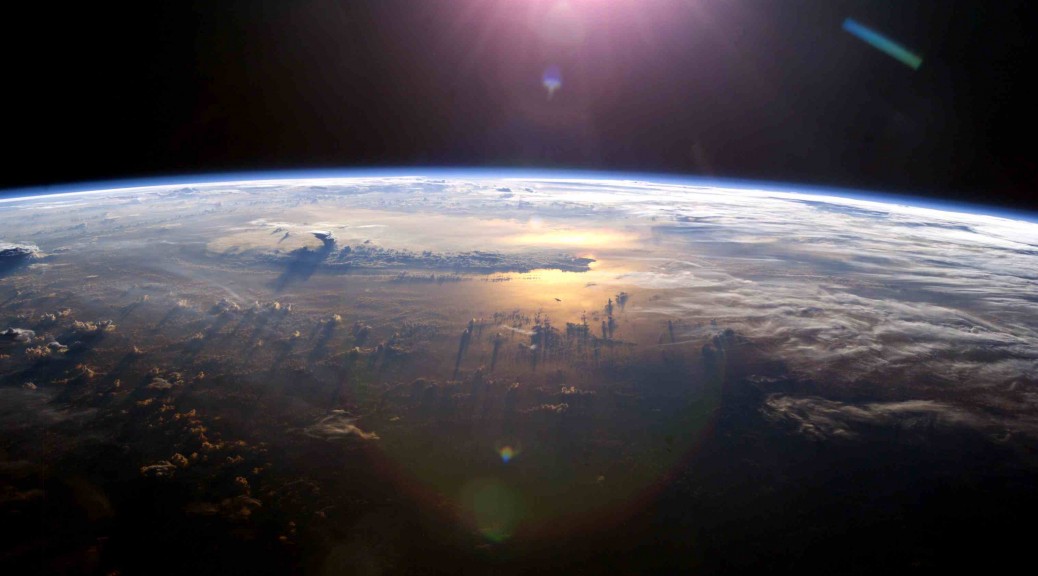Featured image courtesy of NASA’s Marshall Space Flight Center.
Introduction:
I began this series by opining that using sunscreen is a misguided approach to protecting yourself from the sun’s radiation (unless under extreme circumstances), and that we should, in fact, be exposing our bare skin to unfiltered sunlight regularly. By the end of this series (still another few posts), I really hope I will have you convinced!
The second post in this series covered what ‘sunlight’ really is: electromagnetic radiation (EM radiation). We continued on to look at the entire electromagnetic spectrum, after which I explained the major process by which electromagnetic radiation is produced in the sun, and thus what is being emitted by the sun and is blasting Earth: A mix of infrared (IR), visible (VIS), and ultraviolet (UV) radiation (for the most part).
Before sunlight can hit our bodies on the surface of Earth, it has to travel through Earth’s atmosphere. Similar to the way that matter between the center and surface of the sun changes the electromagnetic signature of the sun’s radiation, our atmosphere changes the electromagnetic signature as well. Thus, what is coming out of the sun (solar irradiance) and what is hitting the surface of Earth are different.
The Composition of our Atmosphere:
The atmosphere contains many gases mixed together. It is generally a constant mixture, but can have varying amounts of water vapour, from very dry to quite moist (think the Sahara vs. the Tropics). Since water is the main varying component, typically the composition of the atmosphere described on a dry basis, meaning it is the composition with the assumption that there is no water vapour present. By volume, the atmosphere on a dry basis is composed of about 78% nitrogen (N2), 21% oxygen (O2), and 1% trace gases (everything else). Of the trace gases, the most prevalent is argon (Ar). Other than argon, the trace gases consist of carbon dioxide (CO2), neon (Ne), helium (He), methane (CH4), and a whole variety of others, most notably all nitrogen oxides (NOx, where x can have several values) and ozone (O3).
Ozone is a famous atmospheric constituent. I think most people have a general understanding that the ozone layer protects us from ultraviolet radiation, and that human activities have somewhat depleted the ozone layer so it is less effective than it was. We will come back to this discussion later in the next post.
Solar Irradiance and the Atmosphere:
First, let’s take another look at the solar irradiance emitted by the sun. This time I have included more of the graphic to show how the atmosphere alters what hits the surface of Earth.

I’ve added a few labels to this Wikipedia-adapted graphic used in the last post. The idea is that when electromagnetic energy travels through a medium other than empty space, the atoms/molecules within that medium are going to absorb some of the energy. This is a quantum mechanics related effect whose explanation is beyond the scope of this article, so for this post it is sufficient to understand that specific atoms/molecules absorb specific wavelengths of electromagnetic energy preferentially. This is shown in the above figure by comparing the red spectrum to the yellow spectrum. As labeled, the yellow spectrum is what hits the atmosphere, and the smaller red spectrum is what hits Earth’s surface.
The Atmosphere’s Infrared Absorption:
The IR (heat) portion of the graph is where the now-infamous greenhouse gases get their time to shine. These greenhouse gases absorb and re-emit IR energy in a process known as the greenhouse effect. The theory of global warming says that as the concentration of greenhouse gases increases, the greenhouse effect should be enhanced and more heat energy should be trapped in the atmosphere. I have some criticisms of this theory, but that is the topic of another article. Note: as labeled on the figure, water vapour is in fact the most effective greenhouse gas, not CO2.
The Atmosphere’s Visible Light Absorption:
The above figure shows that visible light is more-or-less trimmed down across all wavelengths. This is because the composition of our atmosphere contains gases that don’t absorb visible wavelengths effectively. Visible light that is lost is generally due to reflection and scattering off of clouds (cloudy days are darker, right?), and a small amount is absorbed by solid particles in the air (soot, dust, dirt, whatever). For the most part, visible light goes right through to the surface. That’s probably why our eyes evolved to “see” it, but it’s likely more complicated than that.
The Atmosphere’s Ultraviolet Absorption:
Ultraviolet (UV) is what the general public is really concerned about because it is thought to cause skin cancer. Most, but certainly not all, of the UV radiation emitted by the sun gets absorbed by the atmosphere before it hits Earth’s surface. UV radiation makes up 10% of the sunlight spectrum in space, but only 3% on Earth’s surface, which means about 70% of it is absorbed by our atmosphere. UV radiation is sub-categorized into three types: UV-A, UV-B, and UV-C. UV-A is the lowest in energy (longest wavelengths), and UV-C is the highest in energy (shortest wavelengths). Each gets absorbed a little differently.
UV-C – This is the super intense stuff. A combination of oxygen and ozone screens this stuff out. Essentially, none of it hits the surface of the earth, or our bodies (unless you’re out in space). Thank goodness for that!
UV-B – This is the medium intense stuff, which is responsible for sunburns. UV-B also causes Vitamin D synthesis when it hits your skin. Vitamin D is an incredibly important hormone that modern humans are often deficient in. I will discuss this in a later post. The vast majority of UV-B is screened out by the ozone layer (97%-99%), but a small amount does get through. This is okay. In a later post I will explain why this is beneficial for us (Hint: Vitamin D).
UV-A – This lowest energy stuff mostly gets through the atmosphere and hits the surface of Earth and our bodies. It doesn’t cause sunburns, but can do some damage to molecules in your body, which is why it is considered a concern for cancer. Again, in a later post, I will explain why this is no big deal.
Here is a Wikipedia graphic that describes the different types of UV getting through our atmosphere (or not):

It is common-knowledge that modern human activities have weakened the ozone layer, so there is a concern that more UV radiation is getting through our atmosphere today than in centuries past. There is, however, a competing anthropogenic (human-caused) effect called global dimming, which as the name implies, is reducing the amount of UV hitting the surface of the earth.
Is ozone depletion balanced out by global dimming? Is the amount of UV radiation hitting the Earth’s surface significantly more than it was in the past? All of these exciting questions will be answered in the next post. Until then my good friends!
As always, if you have any questions or comments, please post away on the blog!

I am really enjoying the theme/design of your website.
Do you ever run into any browser compatibility
issues? A few of my blog readers have complained about my blog
not working correctly in Explorer but looks great
in Chrome. Do you have any suggestions to help fix this problem?
Hello!
I feel a bit confused. According to the diagram above, we could say that water vapor is a bigger contributor to the overall temperature increase (since it absorbes more IR and produces more heat)? Then, should it also be concluded that more (of that) heat leads to further evaporation and even higher vapor content? All of this compared to the commonly blamed CO2 gas which happens to absorb much less radiation.
Hi! Thanks for the comment.
You are correct! It’s called positive feedback. According to NASA: http://www.nasa.gov/topics/earth/features/vapor_warming.html, CO2 also leads to a temperature increase (despite absorbing much less radiation), and this leads to water evaporation, which leads to more of a temperature increase as well.
So – CO2 does have an effect, and it also affects this water loop. I’ve always found this funny, to be honest, as it seems like CO2 absorbs very little compared to water. If NASA says so, it’s likely accurate, however.